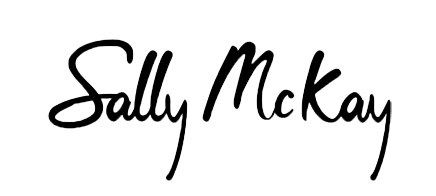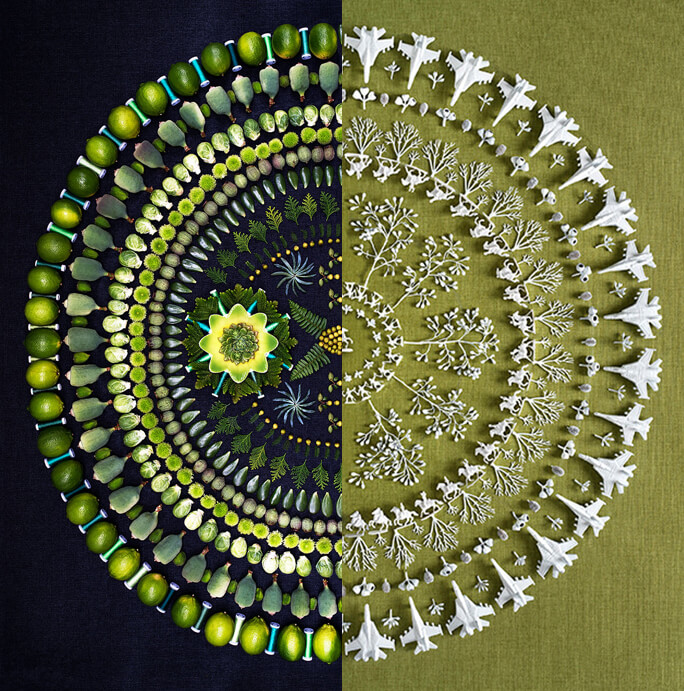By Clare Caldwell – The Authorial
Despite the discernible contrast between McKay’s bodies of work, it is clear that they share a unified message. Their joys and sobering realities ask the audience to ruminate on the impact of humanity on the natural environment. More importantly however, the works demand that the viewer observe what is both within and beyond their own radius so that they may, in the words of Thoreau, understand less but begin to see more.
Blind Radius I, 2017
In her first venture beyond portraiture, McKay undertook an assiduous process of collecting still life objects within her local radius, arranging and then photographing them in a series of meticulous curations of colour. “There is beauty around us that we don’t always experience. These works forced me to slow down, pause and forage,” she explains. Each piece is a homage to the Pantone scale, assembled in hypnotic concentric rings that intersperse items of urban bushland flora with fragments from her domestic setting. The images invite the viewer to come closer, look more critically and understand the works less as art and more as statements on our surroundings. “The juxtaposition of the elements is not random, they’re not accidents. They’re reflections, like a mirror,” says McKay. At first, the viewer may think they recognise the design of a Buddhist mandala in the amphitheatre of found objects that McKay has carefully devised. The familiar acquaintance evokes an intimacy with the work where humble, natural elements sit amongst the miscellany that feed the conversations and fabric of daily life. Teacups, plates and cotton reels mingle with the ephemera of the local landscape – petals, lush produce, fallen autumn leaves. The rhythm of these repeated elements, in cordons of perfectly elliptical lemons, lush hydrangeas and ripening acorns, focuses the audience on the particular, rather than the general. “The most rewarding part of showing my art,” explains McKay, “is seeing people come in close, right up to the glass, and suddenly noticing all the tiny elements that make up the whole.” When this occurs, she says, her art has done its work.
Blind Radius II, 2018
In McKay’s subsequent series, the dialogue is markedly different and asks the observer significantly more challenging questions. Her exceptional capacity to harness colour and light makes for a familiar scene, yet this time the works depict an intersection rather than a symbiosis – one where the natural world and the ‘fast’ economy collide. In these later images, McKay’s message carries weight and provocation, its power emanating from absence rather than abundance. Colour is forced to the background and stark white heroes take centre-stage. Where Blind Radius I had celebrated the rich palette of Australian ora, this later series presents a contrasting story. Part chiaroscuro, part silhouette, each incremental halo generates its own thought-provoking chapter on the often-dichotomous relationship between nature and humanity. “These works are about the non-beauty that surrounds us,” McKay explains. “They’re about environmental damage, about consumerism and the way we package up plastic to appear beautiful.”
From afar, her whimsical patterns take on the appearance of antique lace, but a careful inspection reveals that their dainty ornamentations are indeed dozens of model toy soldiers, figurines from archaic war games and their incumbent plastic artilleries, all frozen mid-pose. In these scenes, the antithetical elements of nature and warfare are disguised in a mutual cloak of alabaster depicting the precarious relationship between our environment and a profligate disposable economy.
In this space, McKay weaves her palette judiciously, right down to the ambiguous nomenclature she uses to speak of beauty. The works’ titles each derive from the French term for lace – dentelle – along with a seemingly synaesthetic reaction to their colour and context: Ardoise suggests the English word arduous, Bleuet conjures bullet, and Grenadine invokes grenade. These instances appear neither accidental nor deliberate, but simply an acknowledgement of the interdependence of colour and emotion in art and life.

